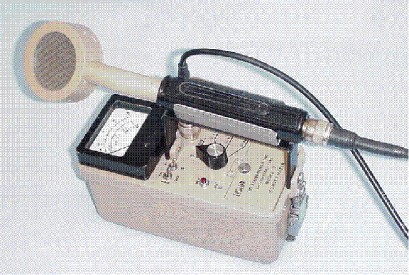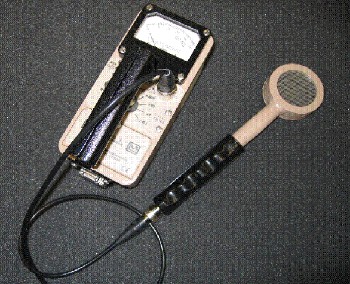Radiation Detection and Survey Devices
- Key Radiation Detection Device Monographs and Articles
- Introduction and Basic Information
- Review of Radiation Dosimeters for Dose Monitoring, Worker Safety, and Environmental Monitoring
- Selection of Radiation Detection Devices by Radiation Incident Response Zone
- More about Selected Examples of Detection Devices
- Multimedia Training about Radiation Detection Devices
- Selected References
-
Disclaimer:
- Reference on this page to any specific commercial product, process, service, manufacturer, or company does not constitute its endorsement or recommendation by the U.S. government or the U.S. Department of Health and Human Services or any of its agencies. Products are displayed as examples only. HHS is not responsible for the contents of any "off-site" Web page referenced on this site.
Key Radiation Detection Device Monographs and Articles
- Musolino SV, Buddemeier B, Finfrock C, Gomera J, Klemic G, Moskowitz J, Roberts T, Schaefer L. Evaluation of Repurposing Archetypal Preventive Radiological/Nuclear Detectors for the Consequence Management Mission. Health Phys. 2019 Jan;116(1):4-17. [PubMed Citation]
- Using Preventative Radiological Nuclear Detection Equipment for Consequence Management Missions, Operational Job Aids, 2017, First Edition (PDF - 1.9 MB) (DHS/NUSTL, RNRR-T-G-3)
- Use of Preventive Radiological/Nuclear Detection Equipment for Consequence Management (PDF - 3.44 MB) (Lecture by Daniel J Blumenthal (DOE/NNSA) at NREP conference)
- Preventive Rad/Nuc Detection Equipment Categorization for Consequence Management (PDF - 1.51 MB) (LLNL-TR-731941, Feb 2016)
- Guidance for Emergency Response Dosimetry, NCRP Report No. 179, 2017
- Radiation Dosimeters for Response And Recovery, Market Survey Report (PDF - 3.15 MB) (DHS/OSTP/NUSTL, June 2016)
Introduction and Basic Information
-
What is Dosimetry?
- Science or technique of determining or quantifying, the local field radiation intensity, radiation dose and dose rate specific type of ionization energy, and other approaches, done in real time manner, or retrospectively, to assess a biologic, or radiation sensitive instrumentation, risk of injury or damage.
-
What are Radiation Dosimeters?
- Devices and methods used for detection of radiation
-
What can be measured by the various kinds of detection
devices?
- Exposure, Kerma, absorbed dose, dose equivalent (absorbed dose multiplied by quality factor, Q, related to severity of absorbed energy)
- Specific types of radiation, (e.g., alpha, beta, gamma, neutron, pion, etc).
- Specific radioisotopes (specific energy peak or spectral energy pattern) and amount present
- Specific levels (or ranges) of incident radiation energy (in kV, MV).
- "Counts" per unit time (minute or second) related to product assignment of energy and a response (i.e. Geiger counters respon with “click” sounds which are triggered levels of absorbed energy translated to units of ionizations occurring in the instrument)
- Roentgens (R) in air per unit time (e.g., milli-Roentgen per hour [mR/hr]), Rem (Roentgen equivalent man): the effect of 100 ergs (one Rad) deposited in a Kg of tissue This is a historical term now relating “to effect” dose vs an “exposure” (field). The Sv is derived from this unit being 0.96 rem in biologic tissue.
- Dose rate (e.g., in units of gray or rad per unit time)
-
Accumulated dose (e.g., in units of gray or rad)
Table 1. Radiological Quantities and Units
Source: Radiation Dosimeters For Response And Recovery, Market Survey Report (PDF - 1.87 MB) (DHS/OSTP/NUSTL, June 2016, See Table 2-1, page 3)Quantity Symbol Traditional Units SI Units Operational Quantities
(for Health Physics purposes)Personal Dose Equivalent Hp rem Sv Ambient Dose Equivalent H* rem Sv Physical Quantities
(for measuring radiation fields)Air Kerma Ka rad Gy Exposure (none) R (none)
-
Where can the radiation be measured?
- Dose from exposure received by people (e.g., whole body, partial body, specific organ exposure)
- In the environment: land, air (including at altitude)
- On the surface of things or people (external contamination)
- Inside people (internal contamination and incorporation, ie tissue uptake, depots), from radioisotopes inhaled, ingested, or received via open wounds
-
Who defines adequate performance standards for radiation
dosimeters?
- The Department of Homeland Security funded the development of a number of ANSI standards to define performance testing requirements for radiation detection equipment used in Homeland Security missions.
-
Device performance metrics, regarding specific radiation
devices, is discussed in the following documents
- Preventive Rad/Nuc Detection Equipment Categorization for Consequence Management (LLNL-TR-731941, Feb 2016)
- Guidance for Emergency Response Dosimetry, (NCRP Report No. 179, 2017)
- Other standards have also been published.
-
What is "Dose Reconstruction": the process (generally mathematically derived) of
estimating the incident doses that workers or members of the public
may have received as a result of exposure to radiation. Reconstruction
is necessary when incident exposures and resultant doses were NOT adequately
measured, if at all, at the time of exposure
- See REMM page about dose reconstruction
- Guidance for Emergency Response Dosimetry, (NCRP Report No. 179, 2017, Chapter 8: Data needs for Dose Reconstruction, provides extensive description of methods)
-
There are many types of radiation detection devices.
- No single device can detect all the various kinds and energies of radiation.
- No one device is useful in all situations. See Table 2 below
-
Do detectors provide radiation information in real
time?
- Radiation survey meters (e.g., Geiger Muller and similar devices) detect radiation in real time
-
Personal dosimeters (“cat whisker” ionization tubes, for example) but most are retrospective requiring instrumentation to interpret, ie alanine chips.
- Film badges do NOT provide information in real time, but they can detect prior radiation exposure if the device was worn at the time of exposure.
- Self-reading personal dosimeters can provide real time information about exposure, with or without alarms reporting accumulated dose or dose rate. For information about capabilities of various kinds of personal dosimeters, see extensive REMM table.
-
Where are the detection devices placed or
located?
- Worn on the body, including on and/or outside of PPE
- Hand carried
- Back pack
- Vehicle mounted (car, truck, boat, aircraft)
- Fixed locations in the environment or a work place
- Attenuation in the way of a source to a detector needs to be known
-
What purposes require radiation monitoring?
-
Occupational setting for radiation
workers who receive training, (e.g., industry, military,
or medicine). The Radiation Safety Officer (RSO) will
- Specify the types of survey meters and personal dosimeters required for given tasks
- Supervise storage, maintenance (batteries, etc;, magnetic field exposures, etc) and calibration of survey meters
- Specify training and proper use of survey meters and personal dosimeters
- Supervise proper issuance and collection of all equipment
- Supervise reporting of dose registered on personal dosimeters
- Preventive Radiological Nuclear Detection (PRND): to detect, locate and identify radioactive material outside of regulatory control; this is a government/NRC/Regulatory role.
-
Emergency response to a radiation incident: This is often called “Consequence Management”. In this setting, detection will have the at
least the following components
- Radiation worker dose monitoring
- Radiation worker exposure control
- Contamination screening for persons and objects
- Radiation survey of the environment
- Isotope identification and quantification
- Monitoring, identifying location of source activity, and minimizing exposure and contamination of non-radiation-workers who become responders and the general public
-
Occupational setting for radiation
workers who receive training, (e.g., industry, military,
or medicine). The Radiation Safety Officer (RSO) will
-
Outdoor Radiation Zones are established
during an emergency response, by sampling air, with or
without aid from computer modeling.
- These zones are defined to plan mission activities and protect responders/members of the public.
- The radiation zone level designations delineate hypothetical lines where identical dose rates (isodose limits) have been measured or calculated, like isobars and isotherms. This not unlike metrology maps of wind velocity isobars.
-
Zones defined by
NCRP
- Dangerous Radiation Zone: >10 R/h (>0.1 Sv/h); inside this line dose rates can be higher
- Hot zone: >10 mR/h (>0.1 mSv/h); inside this line, dose rates can be higher
- Cold zone: < 10 mR/h (<0.1 mSv/h); beyond this perimeter, dose rates will be lower
-
Organizations other than NCRP have different names for
these radiation zones, as noted in the following 3 REMM
pages
- Radiation Control Zones and Perimeters Recommended by Various Agencies for Responding to Radiological Emergencies
- Damage Zones, Radiations Zones and Likely Rescue Activities After a Nuclear Detonation: Table
- Time Sequenced Size of Dangerous Fallout Zone and 0.01 R/Hour Boundary After a Hypothetical 10kT Nuclear Detonation at Ground Level
-
Managing a large radiation incident when local resources
lack sufficient dosimetry capacity or robust radiation
monitoring systems
- Radiation occupational worker and emergency responder radiation dosimetry programs in the US need to service many functions in both very small and large government entities. Every entity cannot afford to purchase and deploy the most sophisticated equipment and systems, especially for a large incident.
- Managing equipment scarcity and program systems in emergencies is the subject of an important new monograph: Guidance for Emergency Response Dosimetry, (NCRP Report No. 179, 2017). See especially 6.2, page 70 for recommendations about criteria for managing with scarce resources.
Review of Radiation Dosimeters Types for Dose Monitoring, Worker Safety, and Environmental Monitoring
Selection of Radiation Detection Devices by Radiation Incident Response Zone
Table 2. Comparison of Radiation Devices by Preferred Response Zone
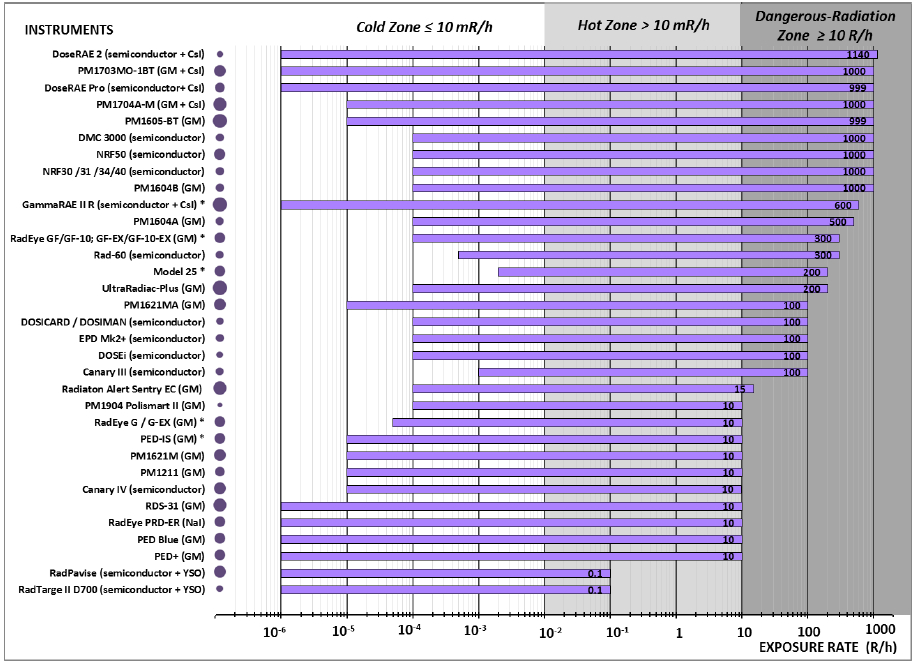
Source: Radiation Dosimeters for Response And Recovery, Market Survey Report (PDF - 1.87 MB) (DHS/OSTP/NUSTL, June 2016, page 9)
- This graphic shows that no one device is appropriate for every situation.
- The x-axis on the bottom of the table above is exposure rate (R/h)
- The x-axis on the top corresponds to Response Zones (Cold, Hot, Dangerous-Radiation) and denotes where each dosimeter type might be most useful. Definition of response zones is shown on the graphic, but various groups have defined the zones differently.
- The y-axis on the left of the graphic lists types of dosimeters that are appropriate for the assigned rose rate work area
- In the source document for this table, the many categories of dosimeters are mentioned with many individual products listed for each type.
More about Selected Examples of Detection Devices
Geiger Mueller (GM) Detectors with Pancake Probes
|
|
|
-
What is a Geiger counter?
(The Vega Science Trust Videos)

- Detects and measures radiation in the environment in real time
- How to survey for external contamination
-
How to Use Hand-held Radiation Survey Equipment (Part
1)
(YouTube - 19:02 minutes) (HHS/CDC)

- G-M Detectors Job Aid - Use a Geiger-Muller survey meter to check for contamination. One page pamphlet. (PDF - 429 KB) (HHS/CDC)
-
What is a "count" of radiation? A “count” is not a unit of radiation but rather a defined (unitized) response capacity of a device to an energy domain and dose rate. The count rate is affected by attenuating material between the dectector and the source and the source energy spectrum.
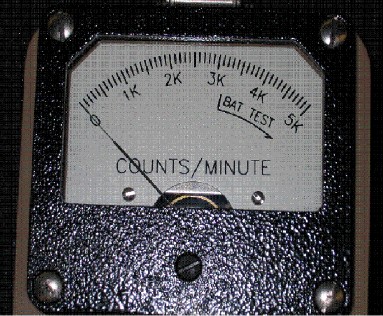
- Radiation energy detected by some devices is registered as a "count."
-
Devices detect only a percent of the total energy
(radioactive decays or disintegrations) released by
radioactive material. This is the solid angle of the source point to the detector vs 4π spherical domain from the point source.
- Efficiency: the percentage of the total radiation energy released that is detected by a device
-
Appropriate "efficiency" conversion factors can be used
to
- Determine the actual number of disintegrations per second or minute (DPS or DPM); requires a standard reference source
- Actual disintegrations per unit of time are measured in units of curies or becquerels
-
Example
- [CPM] divided by [efficiency] equals DPM
- Example: 100 CPM at 20% efficiency = 100/0.2 = 500 DPM
- See Selected References section below.
Alpha Radiation Survey Meter
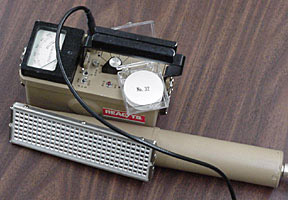
- Radiation survey meter with probe appropriate for detecting alpha radiation.
-
Alpha Scintillation Detectors (Part 3)
(YouTube - 3:54 minutes) (HHS/CDC)

Dose Rate Meter
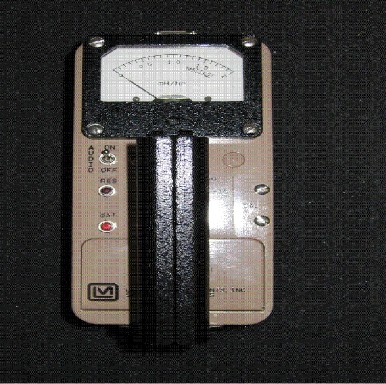
-
This survey meter measures environmental levels of
penetrating, ionizing radiation
- May be used to determine whether it is safe to enter an area and, if so, for how long
- Provide readings in units of roentgens per unit time (e.g., mR/hr)
Personal Dosimeters
-
What is a personal dosimeter?
- A small radiation monitoring device worn by persons entering environments that may contain radiation
- See historical collection of personal dosimeters (ORISE)
-
Who should wear a personal dosimeter?
-
Healthcare or laboratory workers in non-emergency
environments that may contain protected (contained/or open) radiation sources (lead “pig”) or open source exposure fields (Cs-137 and Co-60) sources, for example.
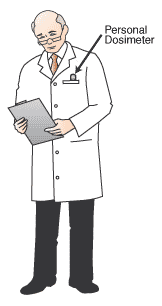
- Examples: radiology, nuclear medicine, and radiation oncology department staff
-
Workers in emergency environments that may contain
radiation
- Examples: first responders and first receivers
-
Workers in industrial environments where radiation is
used
- Examples: nuclear power plant workers or employees at radiation sterilizing facilities, nuclear medicine facilities, etc.
-
Healthcare or laboratory workers in non-emergency
environments that may contain protected (contained/or open) radiation sources (lead “pig”) or open source exposure fields (Cs-137 and Co-60) sources, for example.
-
Where are personal dosimeters usually worn?
- Flat badges are usually worn on the torso, at the collar or chest level, but can be worn on the belt, or forearm
- Ring shaped badges can be worn on the finger when dose to the finger may exceed dose to the badge worn elsewhere on the body, i.e. material handling and source operations or transfers.
-
First responders
and
first receivers
- Wear water-resistant personal dosimeters on the outer layer of personal protective equipment (PPE).
- Should be able to easily see and hear a dosimeter alarm while wearing PPE
- May wear a personal dosimeter underneath waterproof outerwear
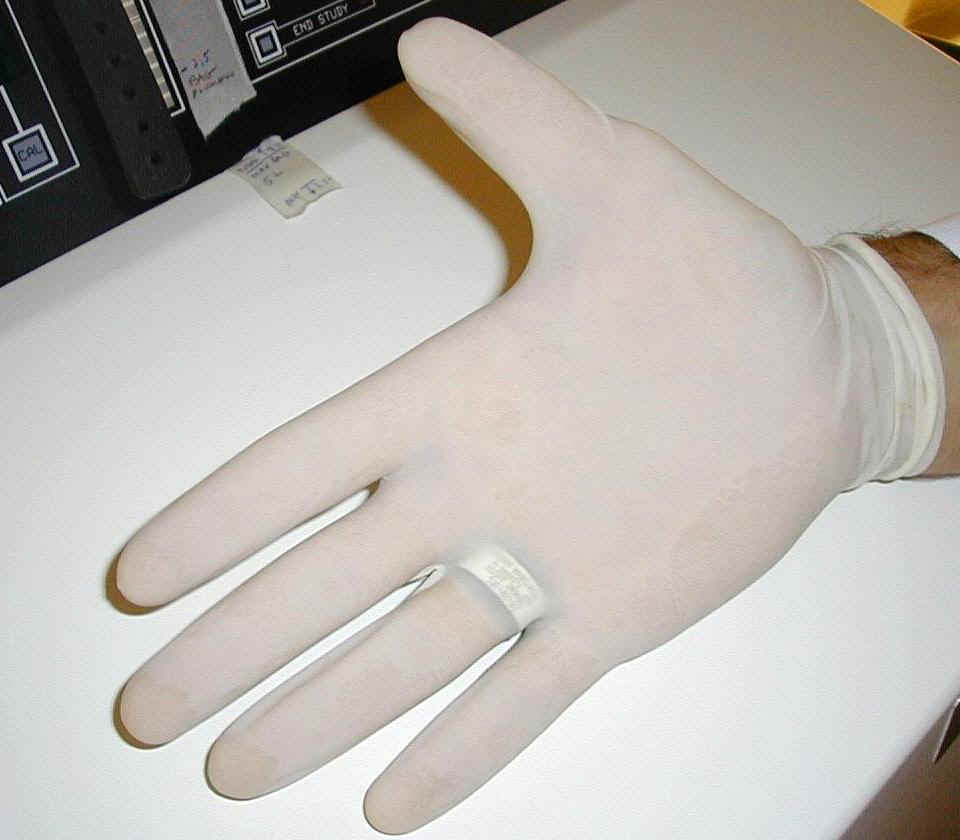
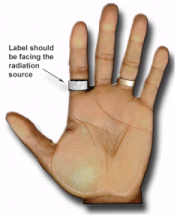

Finger ring film badge inside a glove Finger ring film badge
Source: Harvard University,
Campus ServicesFinger ring film badge
Source: OSHA Hospital eTool -
Radiology Module -
CAVEATS:
-
Radiation exposure in the environment may not be
uniform.
- Dose registered by a badge worn on the torso may not be the same as dose received elsewhere on the body.
- When working close to radiation sources (e.g., removing radioactive shrapnel), the hands/fingers may receive a higher dose than the torso, and should be monitored by a personal dosimeter on the finger.
- Real time readings from personal dosimeters are not available from all devices.
- Emergency responders may require self-reading devices that provide dose information in real time.
-
Radiation exposure in the environment may not be
uniform.
-
Types of personal dosimeters
- See REMM table which reviews many types of personal dosimeters
-
Non-self reading dosimeters: real time dose
information not available
-
Film badges
- Contain filters and film which identify and quantify the type of radiation (e.g., x-rays, gamma, beta, neutron)
- Least accurate personal dosimeter for recording very low exposure (e.g., below about 10 mR)
- Sensitive to temperature and humidity, which may limit use by emergency responders
- Available for use on torso and finger
- See historical collection of personal dosimeters (ORISE)
-
Thermoluminescent dosimeters (TLDs)
- More sensitive than film badges
- Some can measure readings lower (more sensitive) than film badges. Film badges can saturate to no longer respond to added doses; films reach maxima asymptotically – use the most linear response domain to limit the dose maxima
- Use lithium fluoride crystals to record radiation exposure
- Not sensitive to heat and humidity
- Available for use on torso and finger
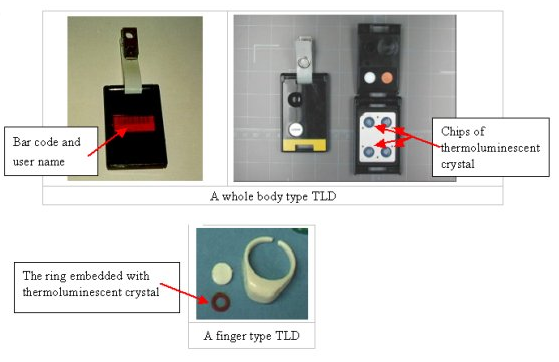
-
Optically stimulated luminescence (OSL)
dosimeter
- More recent device of choice for occupational exposure monitoring
- More sensitive than film badge or TLD
- Use aluminum oxide to record radiation
- Results can be read up to a year following exposure
- Available for use on torso and finger
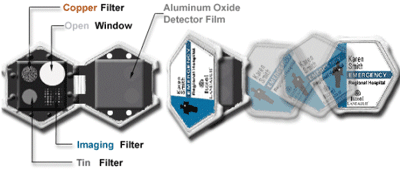
-
Film badges
-
Self-reading dosimeters (aka. direct-reading
dosimeters, self-reading pocket dosimeters, pocket
electroscopes): provide real time dose information
-
Older types:
See historical collection of personal
dosimeters
(ORISE)
- Dose is determined by looking through the eyepiece on one end of the dosimeter, pointing the other end towards a light source, and noting the position of the fiber on a scale
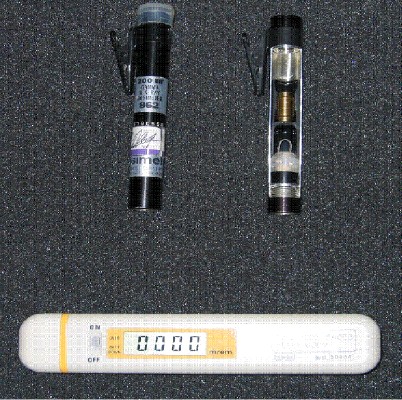
-
Newer types
- Electronic
- Some can measure and display dose rate and total dose
- Some can alert wearer that pre-set dose rate and/or total dose limits have been exceeded by both visual and vibrating alarms
- Dose rate and total dose readings can be downloaded in real time to a computer
- Some are designed for use in extreme environments by emergency responders wearing bunker gear or higher-level PPE (See examples below)
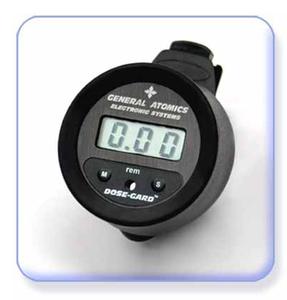
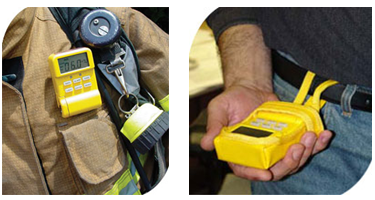
-
Older types:
See historical collection of personal
dosimeters
(ORISE)
Portal Monitors
- Portal monitors are detection systems used to monitor individuals, vehicles, and cargo for radioactive contamination in order to prevent contamination transfer to clean areas. Must be highly sensitive to account for the solid angle limit and source shielding used to reduce the emissions.
- These monitors are used to eliminate the need for individual searches using handheld monitors. Included reports
- Portal Monitors (Wikipedia)
-
Key information from DHS/OSTP/SAVER about Portable Portal
Monitors
- Portable Radiation Portal Monitors Market Survey Report (DHS/OSTP/SAVER Program, March 2015)
- Radiation Portal Monitors: DHS’s Fleet is Lasting Longer than Expected, and future Acquisitions Focus on Operational Efficiencies (GAO-17-57, Publicly Released November 30, 2016)
Multimedia Training about Radiation Detection Devices
-
Basic radiation principles (HHS/CDC)
-
Radiation Principles
(YouTube - 1:52 minutes) (HHS/CDC)

-
Types of Radiation
(YouTube - 1:44 minutes) (HHS/CDC)

-
Radiation Principles
(YouTube - 1:52 minutes) (HHS/CDC)
-
Screening people for external contamination, use of
radiation survey equipment (HHS/CDC)
-
How to Use Hand-held Radiation Survey Equipment (Part
1)
(YouTube - 19:02 minutes) (HHS/CDC)

-
Ionization Chambers (Part 2)
(YouTube - 2:50 minutes) (HHS/CDC)

-
Alpha Scintillation Detectors (Part 3)
(YouTube - 3:54 minutes) (HHS/CDC)

-
Radiation Survey Instruments
(YouTube - 8:51 minutes) (DOE/TEPP/MERRTT)

-
Radiological Dosimetry
(YouTube - 2:02 minutes) (DOE/TEPP/MERRTT)

-
How to Use Hand-held Radiation Survey Equipment (Part
1)
(YouTube - 19:02 minutes) (HHS/CDC)
Selected References
-
What is a Geiger counter?
(The Vega Science Trust Videos)

- How to Perform a Survey for Radiation Contamination
-
Video: Screening People for External Contamination: How
to Use Hand-held Radiation Survey Equipment
(HHS/CDC)

- Use of portable survey meters for initial screening and triage of internally contaminated people (HHS/CDC)
- G-M Detectors Job Aid - Use a Geiger-Muller survey meter to check for contamination. One page pamphlet. (PDF - 429 KB) (HHS/CDC)
- Use of Radiation Detection, Measuring, and Imaging Instruments to Assess Internal Contamination from Inhaled Radionuclides (HHS/CDC)
- Management of Persons Contaminated with Radionuclides: Handbook (NCRP Report 161, Volume I), National Council on Radiation Protection and Measurements, Bethesda, MD, 2008, Chapter 5: Performing Surveys and Controlling Personnel and Area Contamination.
- Handbook for Responding to a Radiological Dispersal Device, First Responder's Guide - the First 12 Hours (Conference of Radiation Control Program Directors, Inc., September 2006)
- Population Monitoring in Radiation Emergencies: A Guide for State and Local Public Health Planners, Second Edition, April 2014. (PDF - 1.02 MB) (HHS/CDC)
- How can you detect radiation? (Health Physics Society)
- Use of Radiation Detection, Measuring, and Imaging Instruments to Assess Internal contamination from Intakes of Radionuclides (HHS/CDC)
- Radiation Portal Monitors: DHS’s Fleet is Lasting Longer than Expected, and future Acquisitions Focus on Operational Efficiencies (GAO-17-57, Publicly Released November 30, 2016)
- Preventive Rad/Nuc Detection Equipment Categorization for Consequence Management (LLNL-TR-731941, Feb 2016)
-
Guidance for Emergency Response Dosimetry
(NCRP Report No. 179), National Council on Radiation
Protection and Measurements, Bethesda, MD, 2017.
- Key table from Report No. 179 showing how to manage worker dosimetry issues with decreasing resources in large mass casualty radiation incident
- Implementation Guidance for Emergency Response Dosimetry (NCRP, Commentary No. 28, 2018): provides details about NCRP Report No. 179)
- Radiation Dosimeters For Response And Recovery, Market Survey Report (PDF - 1.87 MB) (DHS/OSTP/NUSTL, June 2016, page 9 of document)
- Personnel Monitoring (PDF - 817 KB) (REAC/TS)
- Calibration of Radiation Protection Monitoring Instruments, Safety Series Reports No. 16 (IAEA, 2000)
- Pibida L, Estes B, Klemic G, Recalibration Intervals for Radiation Detection Instruments, Technical Note 2146 (Department of Commerce/NIST, 2021)
Disclaimer:
Reference on this page to any specific commercial product,
process, service, manufacturer, or company does not constitute
its endorsement or recommendation by the U.S. government or
the U.S. Department of Health and Human Services or any of its
agencies. Products are displayed as examples only. HHS is not
responsible for the contents of any "off-site" Web page
referenced on this site.


